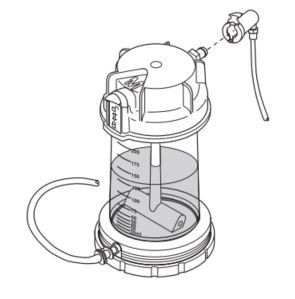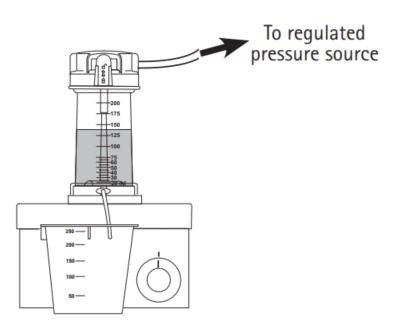User Guide: Amicon® Stirred Cells
Introduction
Amicon® Stirred Cells are designed for rapid concentration and/or diafiltration of macromolecular solutions. Used in conjunction with an external compressed gas source and a magnetic stirrer, the stirred cells provide high concentration factors and high sample recovery. They are ideal for desalting or buffer exchange applications and can be used in either continuous or discontinuous diafiltration mode.
Amicon® Stirred Cell Features
- Pressure-driven filtration coupled with magnetic stirring provides a gentle method for concentration and reduces shear-induced denaturization of biological samples.
- Magnetic stirrer positioned at the filtration interface greatly minimizes the risk of concentration polarization and subsequent fouling of the membrane.
- Three sizes offer a broad range of process volumes (up to 400 mL) that can be further expanded with the addition of an external reservoir.
- The flexible, easy-to-use design can accommodate a wide range of ultrafiltration and microporous membranes at varying pressures and temperatures.
- Minimal holdup volume and easy sample recovery.
- Autoclavable for sterile applications.
Models Available
NOTE: Minimum concentrate volume must be determined empirically by the user since it depends on sample composition and stirring speed.
Operating Modes
Stirred cells can be operated in either a concentration or diafiltration mode. In concentration mode, gas pressure is applied directly to the stirred cell. Solutes larger than the membrane’s molecular weight cutoff (MWCO)/pore size are retained in the cell, while water and solutes smaller than the MWCO/pore size pass through the membrane into the filtrate.
Diafiltration is a fast and efficient technique for desalting as well as buffer exchange of solutions. It can be performed in a batch (discontinuous) or constant volume (continuous) mode.
Discontinuous Diafiltration: The sample is first concentrated to a fixed volume, then diluted back to its original starting volume with water or buffer. Conversely, the sample can be diluted to a fixed volume with water or buffer, then concentrated back to its original volume. Either process is repeated until the remaining salt or solvent is removed or lowered in concentration.
Continuous Diafiltration: Buffer salts are removed, exchanged, or lowered by adding water or exchange buffer at the same rate as the filtrate is collected. Continuous diafiltration is gentler and more efficient than discontinuous diafiltration, as it maintains product stability by keeping the sample concentration and volume constant during diafiltration.
The Amicon® Stirred Cell Reservoir (6028) or Dispensing Pressure Vessel (XX6700P01) can be used for diafiltration applications and to increase the volume capacity of the stirred cells. In continuous diafiltration mode, the reservoir/pressure vessel containing diafiltration solution is connected to the stirred cell and gas pressure supply via the Amicon® Stirred Cell Selector Valve (6003) or similar user-supplied valve(s). The selector valve allows instant switching between concentration and diafiltration modes without interrupting system operation. The combination of an external reservoir and the Amicon® Selector Valve create a simple diafiltration system that keeps the stirred cell fluid volume and macrosolute concentration constant as the filtrate volume is replaced by the diafiltration solution. In either mode, the Amicon® Stirred Cell Manifold (6015) can be used to operate multiple stirred cells in parallel.
Amicon® Stirred Cell Components
Materials Required but Not Supplied
- Ultrafltration or microfltration membrane discs
- Magnetic stirrer
- Source of clean, regulated, compressed air or nitrogen with tube fttings/connectors appropriate for connecting to ¼ in. outer diameter (OD) tubing at the desired operating pressure
- Collection containers
Pressure Limitation
Do not operate the stirred cell above 5.2 bar (75 psi).
Assembly and Operation
Concentration Mode
- Snap membrane holder onto base.
2. Place membrane into membrane holder, oriented as indicated in membrane instructions (shiny side up for ultrafltration membranes). Place O-ring on top of membrane and push down gently to seat membrane in holder.
NOTE: See membrane instructions for rinsing and chemical compatibility. Handle membrane by edge to avoid scratching or contaminating surface.
3. Align filtrate port on membrane holder with slot in bottom of cell body. Screw base into cell body.
4. Attach filtrate tubing assembly to filtrate port on membrane holder.
5. Insert stir bar into cell body until support ring is seated on ridge inside the top of cell body.
6. Pour desired sample into cell.
7. With cap oriented as shown, seat large diameter of gasket in gasket groove. Gently push the gasket down to seat it fully.
IMPORTANT! To avoid leakage between cap and cell body, make sure that the gasket is free of dirt/debris and oriented correctly in the cap.
8. Screw cap onto cell body until it stops.
9. Move blue slide-lock downward to close pressure relief valve and lock cap in place.
10. Attach pressure inlet tubing assembly by inserting female connector onto quick-connect fitting on cap until it clicks

11. Place stirred cell on magnetic stirrer and insert filtrate tubing into an appropriate collection container.

12. To concentrate, connect free end of the ¼ in. OD pressure inlet tubing to a regulated pressure source. To increase the volume capacity of the stirred cell using the Amicon® Stirred Cell Reservoir and Amicon® Stirred Cell Selector Valve, refer to the setup described in Diafltration Mode.
NOTE: Use clean compressed air or nitrogen gas for pressurizing the cell. With sensitive solutions, compressed air can cause large pH shifts, due to dissolution of carbon dioxide. Oxidation may also occur.
WARNING: Do not exceed pressure limit of 5.2 bar (75 psi).
13. Initiate stirring and pressurize stirred cell to desired pressure. Refer to membrane instructions for optimal operating pressures.
NOTE: Ensure that stir bar is not touching the membrane surface. For unsupported membranes, pressurize stirred cell prior to stirring.
14. Collect filtrate until desired concentration factor is achieved.
Diafiltration Mode
For discontinuous (batch) diafltraton, concentrate to a desired level then dilute back to the starting volume. Repeat this process until the remaining salt or solvent is removed or lowered in concentration.
For continuous (constant volume) diafiltration, connect the stirred cell to an external reservoir (e.g., 6028), via the Amicon® Stirred Cell Selector Valve (6003), or similar user-supplied valve(s) to control gas and liquid output independently. The selector valve can be used to switch instantly between concentration and diafiltration modes without interrupting system operation. Refer to corresponding user guides for detailed instructions.
NOTE: During continuous diafiltration, the pressure should not exceed 3.8 bar (55 psi), in order to maintain equilibrium between the stirred cell and the reservoir. If the liquid level increases slightly, concentrate briefly.
WARNING: To prevent fluid from entering the stirred cell pressure relief valve during continuous diafiltration, do not exceed the maximum working volume (e.g., 50 mL for the 50 mL stirred cell).
Operating Multiple Cells in Concentration or Diafltration Mode
In either mode, an Amicon® Stirred Cell Manifold (6015) can be used to operate multiple stirred cells in parallel. Refer to the manifold user guide for detailed instructions.
Shut down and disassembly
- Once filtration is complete, turn off pressure at the source, then turn off magnetic stirrer.
WARNING: Do not disconnect pressure inlet tube until stirred cell is depressurized.
NOTE: To maximize recovery of retained substances, continue stirring for a few minutes after depressurization to resuspend the polarized layer at the membrane surface.
- Move blue slide-lock upward to vent residual pressure and disengage cap lock.
3. Disengage the quick-connect fitting by pressing down on the metal tab and pulling the fitting away from the cap.
4. Unscrew cap and remove from cell body.
5. Remove stir bar and recover concentrated sample. Save filtrate sample if required.
Troubleshooting
Cleaning, Maintenance, and Storage
- After each use, the stirred cell and all fluid-carrying tubing should be cleaned with mild laboratory detergent and rinsed with deionized water.
- Replace O-ring and gasket at the first sign of damage or wear.
- Periodically inspect the cell body for cracks and inspect the stir bar for washer wear or rough edges which could damage the membrane.
WARNING: Do not use stirred cell if cell body is cracked or crazed. - Disassemble the stirred cell whenever it is unlikely to be used for several weeks.
- Store all components at room temperature.
Sterilization/Sanitization
Amicon® Stirred Cells are compatible with standard sterilizing gas mixtures. They can also be autoclaved for at least 10 cycles at 121 °C, 1 bar (250 °F, 15 psi) for 30 minutes, with slow exhaust cycle. However, due to variables beyond our control, no warranty is provided or implied for more than 10 autoclave cycles. The pressure inlet tubing assembly is NOT autoclavable.
WARNING: To avoid damage to the cell body, the base and cap should be only partially tightened before autoclaving.
To sanitize, use 70% ethanol or isopropanol. To disinfect, use 5% formalin.
Chemical Compatibility
Do not use the stirred cell with strong acids or bases (pH < 2 or > 10), ketones (including acetone), aromatic hydrocarbons (including toluene), Cellosolve® solvent, halogenated hydrocarbons, dimethyl formamide, aliphatic esters, dimethyl sulfoxide, and polar aromatics.
For other solvent compatibilities, consult a standard text or contact Technical Service. For the chemical resistance of disc membranes, refer to product instructions.
Specifications
Materials
To continue reading please sign in or create an account.
Don't Have An Account?